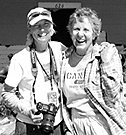Wednesday, November 23, 2005
The paintings that line the walls of H.C. Porter's studio on Millsaps Avenue portray, in boldacrylics and prismacolor, scenes from her youth. All the subjectsare African American.
Yet, Porter is a slight, 42-year-old white woman with wispy blonde hair.
"People have (tried) to question my right to do another culture in my artwork—which is interesting, because Gauguin didn't sit around and paint his European buddies. He fell in love with Tahiti. It's what you see," Porter explains.
For the next year, Porter plans to document the lives of othercommunities—black, white, Hispanic or Vietnamese—as they struggle to dealwith the aftermath of Hurricane Katrina. "Rebuilding Mississippi: Backyardsand Beyond," will be a series of 70 to 80 paintings executed in Porter'ssignature style. Since the second week after Katrina hit, Porter hascaptured 5,000 black-and-white photographs of the storm's aftermath. She isnow transferring the images to silk screen, and then applying an intenselayer of paint. Porter hopes to have the exhibition ready by spring 2007.
Your work has been exhibited in cities like Paris and New York. Why did you remain in Jackson?
My support was here, so I came back to Jackson (after college). My grandparents were very generous with their space. They turned me loose down (in the basement). I think I was asked to pay $25 a month in rent just to keep me honest. I couldn't print-make on certain days because the fumes would waft up through the hardwood floors, and it was more than my grandmother could stand sometimes. I've always said I'm a Mississippi artist.
What is the appeal of the bold colors and contrasts of your paintings?
It adds to the emotion, I think, and it brings the hope that you might not see immediately. Through the years, people have been attracted to the color, and they have responded to the subject that they're seeing there. In doing that, what each individual brings is their own experience. The viewer obviously holds the final step in completing everything.
When did you decide to chronicle the aftermath of Hurricane Katrina?
That day when everybody had to make the decision to get out, I was supposed to be in Lancaster, Pa. The hurricane was supposed to come in on Monday, and we realized that we had to go ahead and get out so that we could make it. So here we are away from everything, and seeing images on television that you guys couldn't even see, really, and just being overwhelmed and devastated. We still had to go to work, set up my show, do my show, deal with the public. It was the public's response to everything. Here they'd been seeing images on CNN or wherever, and they were just out trying to get away from it. They felt they were sort of encountering in my work the emotionality—obviously the black community they were seeing on television. ... That encouraged me to use my work to be able to bring attention to what Mississippi is living through.
What vision do you have for "Rebuilding Mississippi?"
I can see a large exhibition of paintings. My goal is to put together 80 paintings that will be reflections of people dealing with their lives at this point, showing the devastation either directly or indirectly and how we've adapted to our everyday lives. We've been going down there since two weeks after the storm. We've spent I don't know how many weeks down there. ... We're also doing audio recordings of each individual.
How can you do this financially?
The first thing we're doing is giving patrons of my work the opportunity to come in and privately own one of the pieces that will be in the show. What's interesting about that is they don't know which piece it's going to be. Once I fill the show and have pre-sold the pieces, there's going to be a lottery of some sort. …What I want to make clear is that I'm still looking for sponsorships. It's not like every painting is sold. We're looking at corporate sponsorships. Through the sponsorships, you'll be funding one of the most important projects that I'll ever do.
What else are you up to?
This is so all-consuming. It's difficult even to take time to take the garbage out right now. I'm preparing for a show at Southern Breeze, and that has nothing to do with Katrina; it's the work that I've always done. (But) for me, it's difficult to not want to be down on the Coast every second, because I feel like there's so many aspects of the story that I want to tell and that I'm missing things.
H.C. Porter's show at Southern Breeze opened Nov. 23. Call 601-982-4222.

Comments
Use the comment form below to begin a discussion about this content.
Sign in to comment
Or login with:
OpenID